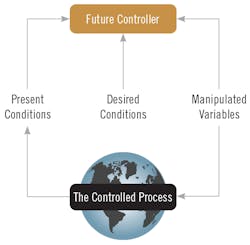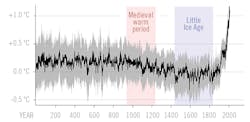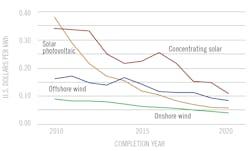When society started to focus on the global warming process, I noted that each group of experts analyzed it from the perspective of their own fields of specialty, and I decided to check if my conclusions would agree, particularly if I analyzed it by taking into consideration all the complex sub-processes? I spent the last three years trying to fully understand the overall dynamic "personality" of this process to see if my conclusions would differ from the other predictions that were circulating.
This effort resulted in a 600-page book (Figure 1), which I believe provides a more accurate and different perspective of what has to be done and when?
The process
The temperature of any object is kept constant, if the heat entering and leaving it are the same and constant. At the beginning of the industrial revolution, the Earth was in heat balance. Its average temperature was about 14°C, and it absorbed 70% of the incoming solar heat, while reflecting 30% of it back into the cold outer space. Today, the average temperature is nearly 15.2°C (a 7% increase).
Once mankind needed more energy than provided by nature, it started to supplement that energy by burning the accumulated fuel underground. While during the past one million years the CO2 concentration of the air never exceeded 300 parts per million by volume (ppmv). In spite of volcanic activity and meteorite impacts, it increased to 420 ppmv during the industrial age. This extra 120 ppmv of greenhouse gases (GHG) is about 1,000 gigatons (GT), which equals the weight of one million Empire State Buildings. Today, we are emitting about another 50 GT each year, which amounts to 13 kg of GHG per capita every day (not every year or month, but day). This emission causes an increase in GHG concentration by about 2.5 ppmv/yr and is rising, because of Putin's war.
Measurable results
The GW control loop in Figure 1 consists of three main components: the sensors, the controller and the control valve, and this loop today does not exist. GW is out of control and is rising. Only one of the loop components: the sensors measuring the actual values of GW and CO2 are functioning.
If CO2 had a color, the sky would be darkened by it, and nobody would call climate change a "hoax". Instead, we have excellent satellite mounted CO2 detectors, which measure not only its concentration, but also the quantities of local emissions. For example, it was reported that a single natural gas field in Algeria releases 73 million tons (MT) of GHG yearly, (natural gas is basically methane, which is 25 times more powerful than CO2.). A steel factory in China emits 22 MT, and even a single coal burning power plant in Virginia spills out 10 MT.
Our temperature sensors and our thermometers are also excellent, accurate to about 0.002°C, today they measure the average GW at the ocean surfaces as about 0.7°C and the global GW is rising at a rate of nearly 0.25°C per decade. In certain locations, such as the Arctic, GW has already reached 4.0°C.
The yearly quantity of heat absorbed by the planet is estimated to be about 5 million Q (Q = 1015 BTU) of which about 30% is reflected into space. The remaining 3.5 million Q is absorbed by Earth. This quantity is equivalent to the heat release of 5 Hiroshima-sized nuclear bomb every second. About 90% of the total heat absorbed by our planet is absorbed by the oceans. Over the industrial age, the oceans accumulated an immense amount of heat which is accurately measured by 4,000 Argo floats distributed in the oceans around the world. These floats continuously travel down to a depth of 2,000 meters and back and report the rising temperature profile with an accuracy of about ±0.002°C.
- The oceans have a mass 200 times that of the atmosphere and respond slowly, but their effects will grow with time.
- GW is also rising, because heat reflection is decreasing as the melting snow is being replaced by heat absorbing water and land.
- CO2 solubility in the oceans is decreasing as its temperature is rising, causing "degassing" of CO2.
- Methane release will start as the one-mile thick permafrost layer, covering 15% of the Northern Hemisphere melts.
- Increase of CO2 emission due to deforestation continues.
- Increase in humidity in the air causes additional GW through its greenhouse effect.
- Positive feedback effects cause self-acceleration: For example, polar melting increases GW by reducing heat reflection, which further increases GW.
- Cooling the planet by "whitening" the human footprint (using more reflective agricultural, road and building surfaces is not considered at all.
- It is often not realized that even after CO2 emission is stopped, GW rise will only slow, but not stop because the already accumulated CO2 stays in the air.
- The goal (the set-point) of control should not be a temperature limit, but the date by which the use of fossil-nuclear energy is fully replaced by solar-hydrogen.
As can be seen from the above list, my process control analysis shows that GW is out of control and large-scale immediate action is needed to avoid disaster. On the other hand, I am still optimistic, because the cost of green energy is dropping (Figure 3) while the cost of fossil fuels is rising and therefore the conversion effort to a solar-hydrogen energy economy is already profitable, not to mention that once it is started, it will trigger an economic boom not seen since the end of World War II.
About the Author
Béla Lipták
Columnist and Control Consultant
Béla Lipták is an automation and safety consultant and editor of the Instrument and Automation Engineers’ Handbook (IAEH).

Leaders relevant to this article:




